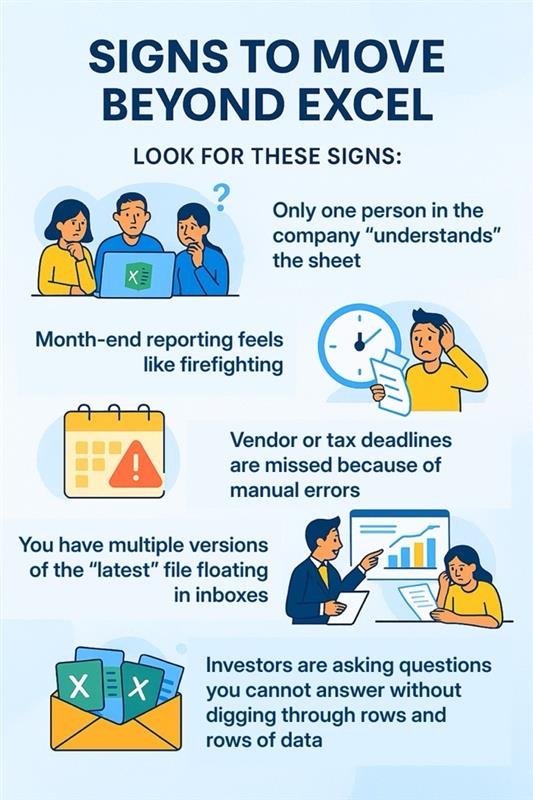In the early stages of building a business, founders often wear multiple hats. They sell, they recruit, they strategize — and they also track - revenues, costs, vendor dues, investor metrics — everything gets recorded, often meticulously, in a spreadsheet. And rightly so. Excel or Google Sheets is one of the most accessible, flexible tools ever created. It gives a sense of control, of order, and even empowerment.
But there’s a quiet danger hidden in this familiarity. Because spreadsheets do work — until they don’t.
How spreadsheets become a trap
What begins as a simple sales tracker slowly becomes a maze of linked sheets, lookup formulas, and custom macros. A payment schedule turns into a cash flow planner, which doubles as a project tracker. A sheet meant to calculate expenses suddenly starts serving as a proxy for inventory.
It works — until it doesn’t.
One missed entry, one broken formula, or one hidden error, and the whole thing collapses. The worst part? The complexity isn’t visible to anyone else. It often lives entirely in the head of the founder or the one finance person who set it up. If that person steps away, the business loses not just a tracker, but the very logic on which key decisions were being made.
This is what I call ‘the Excel Trap’.
It’s the illusion of control — where founders feel they are managing their finances because they have everything “in one place.” But in reality, they’re building a system that becomes harder to scale, harder to explain, and dangerously prone to error.
The illusion of control
Founders often defend their use of spreadsheets by pointing to how “customized” they are. “This sheet is designed exactly for my business,” they say. And in some ways, that’s true. Spreadsheets are flexible enough to handle any calculation or structure.
But customization without governance is chaos. There are no audit trails, no access controls, no structured approvals. Numbers can be changed without accountability. Historical records are easily lost.
A growing startup cannot afford that. Investors expect reliable numbers. Banks want timely reconciliations. Vendors demand clarity. Employees expect salaries on time. An Excel file, no matter how detailed, cannot provide that level of structure.
Spreadsheets vs. Systems
The truth is, spreadsheets are built for calculation, not collaboration. They are meant to record data, not interpret it. And they certainly aren’t designed to track accountability across roles, processes, and timelines.
Modern financial systems, on the other hand, are designed for scale. They enforce internal controls, capture audit trails, and generate insights in real time.
Take , TallyPrime for instance. For an early-stage business, it’s not just accounting software — it’s a financial backbone. With right TallyPrime set up (with or without customization), businesses can track receivables, automate GST filings, and reconcile bank statements in ways that eliminate human error.
Or consider Microsoft Power Platform. Using Power BI dashboards, a founder can track cash flow trends visually instead of scanning rows of numbers. With Power Automate, recurring payment reminders can be triggered automatically. And custom Power Apps can help in building lightweight approval workflows that spreadsheets could never replicate.
These aren’t enterprise luxuries anymore. They’re practical, accessible tools for small teams that want to stay agile.
Why founders delay the transition
If these systems are so beneficial, why do founders resist them? The reasons are surprisingly consistent:
- “We’re too small right now.”
The assumption is that only large enterprises need structured systems. But small teams are exactly where discipline matters most. A leak of ₹50,000 in a 10-person startup is far more damaging than in a large corporation.
- “We don’t have the budget.”
Modern solutions are modular and affordable. A TallyPrime license or a Power Platform app cost less than a month of lost productivity caused by spreadsheet confusion. The real cost is not the software — it’s the risk of delay.
- “We’ll set it up once we grow.”
Growth is when cracks widen. Once you have multiple stakeholders demanding reports, switching systems becomes painful. The transition is easiest when you’re small.
Early warning signs you’re in the excel trap
How can a founder know when it’s time to move beyond Excel? Look for these signs:

- Only one person in the company “understands” the sheet.
- Month-end reporting feels like firefighting.
- Vendor or tax deadlines are missed because of manual errors.
- You have multiple versions of the “latest” file floating in inboxes.
- Investors are asking questions you cannot answer without digging through rows and rows of data.
If even one of these is true, the trap is already set.
The mindset shift
What many early-stage leaders fail to realize is that a financial system isn’t just a tool. It’s a mindset. It’s the decision to treat finance not as a chore but as a foundation — something that can support scale, speed, and strategy.
Think of it this way: You wouldn’t build a multi-storey building on temporary bamboo scaffolding. Yet, by relying only on spreadsheets, that’s exactly what founders do with their businesses.
Modern systems aren’t about bureaucracy. They’re about clarity, continuity, and confidence. They make finance less about reactive record-keeping and more about proactive decision-making.
A competitive advantage
In today’s startup world, where capital is precious and decisions are fast, financial structure is not optional. It’s a competitive advantage.
A startup with a real-time dashboard knows sooner when cash is running low — and can adjust before a crisis. A startup with automated receivable tracking can collect faster than competitors. A startup with structured approval flows avoids fraud and leakage.
And most importantly, a startup with reliable financial reporting wins investor trust.
Final word: Beyond spreadsheets
Spreadsheets will always have their place. They are brilliant for modelling, for analysis, for quick calculations. But they are not — and never were — meant to be the backbone of finance operations.
So, to every founder still wrestling with sheets and workarounds, my suggestion is simple: Don’t wait for the cracks to widen. Don’t make financial structure a post-growth problem. The earlier you transition to a system — even a basic one — the smoother your growth journey will be.
After all, your startup deserves more than a spreadsheet.










